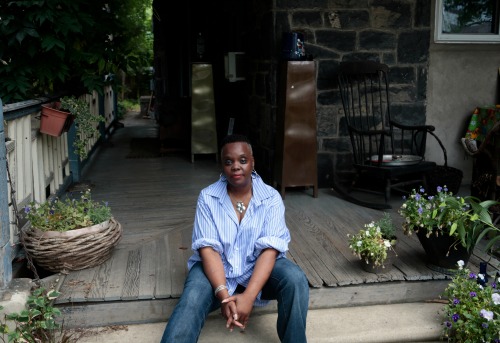
PHILADELPHIA (AP) _ Nestled in Philadelphia’s historic Germantown neighborhood, the Victorian facade of The Colored Girls Museum beckons visitors past its gate, up the flower-lined path and onto the inviting wraparound porch.
Inside, objects ranging from quilts to a bag of black-eyed peas honor the culture and experiences of what museum founder and artist Vashti Dubois calls “everyday black girls.”
“This museum is a celebration of the ordinary, extraordinary colored girl,” said Dubois. Referring to the house as a living thing, she adds: “She’s speaking to the girl in us.”
The 127-year-old home with high, earth-toned walls is filled with art, artifacts and treasures that take visitors on a communal journey of loss, joy, healing and memory.
In one corner, spectacles and a piece of peppermint candy sit on the open pages of a Bible. In another room, brown-faced dolls beg to be picked up and have their yarn hair stroked.
Bright quilts hang on walls and lie folded across chairs and shelves, adorned with the words, images and even the clothing scraps _ buttons, a piece of a nightgown _ of previous generations.
The sight of a bag of black-eyed peas lying in the kitchen can trigger a smile of recognition among visitors who grew up eating this staple of African-American home cooking. In the sitting room, hanging fans memorialize four black girls killed in the 16th Street Baptist Church bombing in Birmingham, Alabama, in 1963.
Many rooms display books that have provided refuge and affirmation for countless black girls, including well-worn titles by African-American women like Maya Angelou, Toni Cade Bambara, Zora Neale Hurston. The house is also filled with music that has served as the soundtrack for several generations of Saturday morning chores and Friday night parties, from Nina Simone to Michael Jackson.

Together, the artifacts are transformed into treasures connecting visitors to the culture of black girls, the women who love and nurture them in an often hostile world, and the collective strength of black women past and present.
Museum board member and writer Barbara Neely says there is power in these displays of “the things we have handled and the things that we use … almost like a physical salve. Being here is like being healed and centered.”
For Neely, one doll in particular transported her back to her black girlhood in northern Pennsylvania.
“By the time I was in my late teens, all I wanted to do was get the hell out of there,” Neely recalled, remembering the racism she encountered. “I do not spend a lot of time thinking about that. But something about that doll reminded me that I’d thrown the baby out with the bath water.” She says the museum helps visitors “reclaim those things that we knew were valuable, but that we were told were not.”
The museum opened last year. Each room is curated by a different artist and dedicated to different black women, some famous, some not, with their work and objects shown alongside Dubois’ family belongings. Many displays are personal tributes to mothers and grandmothers, black women plain and proud, whose lives offer lessons.
“When you think about a museum, about who even visits a museum, it’s not ordinary girls and women of color,” said artist Marie-Monique Marthol-Clark, one of the artist curators. But this museum “brings us from the margins to the center and elevates us, not only those who are celebrities or have a certain degree of accomplishment.”

One room, dedicated to black laundresses, shows off a grandmother’s Sunday best: the dress and hat she wore to church on the one day a week that belonged to her and not the white family she worked for. Her bottle of French perfume sits on an end table nearby. Langston Hughes’ poem “A Song to a Negro Wash-Woman” is also on display.
In the back of the house, a toolshed curated by Marthol-Clark is dedicated to a celebration of creativity as “a survival tool.”
“When you use something on a day-to-day basis, you may not recognize that as a gift and a skill,” she said. “We may even take that for granted because everyone else does. So this is about correcting and curing that.”
___
If You Go…
THE COLORED GIRLS MUSEUM: 4613 Newhall St., Philadelphia, http://www.thecoloredgirlsmuseum.com . Open Sundays noon-4 p.m. and by appointment. Suggested $10 donation. On July 9, the museum hosts its first pop-up festival at the Philadelphia Fringe Arts Center, a community dance party with music, artists and vendors in celebration of “black girl magic,” a cultural catchphrase that has become a popular social media hashtag. This fall, the museum presents its first exhibit, “A Good Night’s Sleep” at the center’s Fringe Festival.


